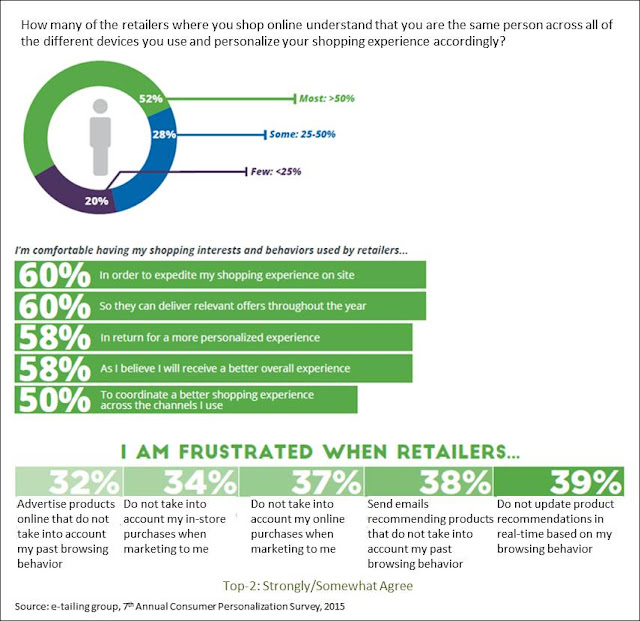But you, Dear Reader, get the benefit of my crazy little binge. Here’s a fact-filled blog post that uses some my carefully assembled information. (Yes, there was actually much more. I’m so ashamed.)
Customer Expectations are Rising
Let's start with a truth universally acknowledged – that customers have rising expectations for personalized treatment. Unlike Jane Austen, I have facts for my assertion: e-tailing group's 7th Annual Consumer Personalization Survey found that 52% of consumers believe most online retailers can recognize them as the same person across devices and personalize their shopping experience accordingly. An even higher proportion (60%) want their past behaviors used to expedite the shopping experience, and one-third (37%) are frustrated when companies don’t take that data into account.
 Switching to customer service, Microsoft’s 2015 Global State of Multichannel Customer Service Report found that 68% of U.S. consumers had stopped doing business with a brand due to a poor customer service experience and 56% have higher expectations for customer service than a year ago. So, yes, customer expectations are rising and failing to meet them has a price.
Switching to customer service, Microsoft’s 2015 Global State of Multichannel Customer Service Report found that 68% of U.S. consumers had stopped doing business with a brand due to a poor customer service experience and 56% have higher expectations for customer service than a year ago. So, yes, customer expectations are rising and failing to meet them has a price.Marketers Know They Need Data
Marketers certainly see this as well. In a Harris Poll conducted for Lithium Technologies, 82% of 300 executives agreed that customer expectations have gotten higher in the past three years. Focusing more specifically on data, Experian's 2015 Data Quality Benchmark Report, which had 1200 respondents, found that 99% agreed some type of customer data is essential for marketing success. Marketers are backing those opinions with money: when Winterberry Group asked a select set of senior marketers what was driving their investments in data-driven marketing and advertising, the most commonly cited reason was the need to deliver more relevant communications and be more customer-centric. .
Few Have the Data They Need
But marketers also recognize that they have a long way to go. In Experian’s 2015 Digital Marketer study, 89% of marketers reported at least one challenge with creating a complete customer view.
Econsultancy’s 2015 The Multichannel Reality study for Adobe found that just 29% had succeeded in creating such a view, 15% could access the complete view in their campaign manager, 14% integrate all campaigns across all channels, and 8% were able to adapt the customer experience based on context in real time. In other words, the complete view is just the beginning. In other words, marketers are nowhere near as good at personalizing experiences as consumers think.
Real-Time Isn't a Luxury
Given the challenges in building any complete view, is real-time experience coordination too much to ask? Customers don’t think so; in fact, as we've already seen, they assume it’s already happening. Marketers, of course, are more aware of the challenges, but they too see it as the goal. In a survey of their own clients, marketing data analysis and campaign software vendor Apteco Ltd found that 12% of respondents were already using real-time data, 31% were sure they needed it and 37% felt it might be useful. Just 17% felt daily updates were adequate.
Real-Time Must Also Be Cross-Channel
It’s important to not to confuse real-time personalization with tracking customers across channels or even identifying customers at all. In a survey by personalization vendor Evergage, respondents who were already doing real-time personalization were most often basing it on immediately observable, potentially anonymous data including type of content viewed, location, time on site, and navigation behavior. Yet the marketers in that same study gave the highest importance ratings to identity-based information including customer value, buying/shopping patterns, and buyer persona. It’s clear that marketers recognize the need for a complete customer view even if they haven't built one.
Summary
What are we to make of all this, other than the fact that I need to get out more? I'd summarize this in three points:
- customer expectations are truly rising and you'll be penalized if you don't meet them
- marketers know that meeting expectations requires a complete customer view but few have built one
- the complete view has to be part of a real-time integrated, real-time to deliver the necessary results
None of this should be news to anyone. But perhaps this data will help build your business case for investments to solve the problem. If so, my lost weekend will not have been in vain.
.










No comments:
Post a Comment